

Grow and cook 11 herbs (and no spices) Citrus, spice, licorice, sweet, sour, pungent.
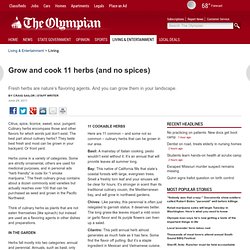
Culinary herbs encompass those and other flavors for which words just don’t exist. The best part about culinary herbs? They taste best fresh and most can be grown in your backyard. Or front yard. Nshima. Nshima (top right corner) with three relishes Name[edit] Nshima, also known as nsima, is the same as ugali (bukari).
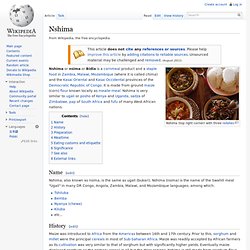
Nshima (nsima) is the name of the Swahili meal "Ugali" in many DR Congo, Angola, Zambia, Malawi, and Mozambique languages; among which: Tandoor. A tandoor (Sanskrit: कन्दु,[1] Arabic: تنور, Persian: تنور, Turkish: tandır, Urdu: تندور, Armenian: Թոնիր, Azerbaijani: təndir, Hindi: तन्दूर, Bengali: তন্দূর, Georgian: თონე, Punjabi: ਤੰਦੂਰ, Uyghur: تونۇر/tonur, Chinese: 馕坑) is a cylindrical clay or metal oven used in cooking and baking.
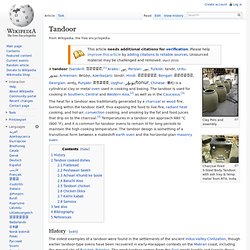
The tandoor is used for cooking in Southern, Central and Western Asia,[2] as well as in the Caucasus.[3] The heat for a tandoor was traditionally generated by a charcoal or wood fire, burning within the tandoor itself, thus exposing the food to live-fire, radiant heat cooking, and hot-air, convection cooking, and smoking by the fat and food juices that drip on to the charcoal.[3] Temperatures in a tandoor can approach 480 °C (900 °F), and it is common for tandoor ovens to remain lit for long periods to maintain the high cooking temperature. The tandoor design is something of a transitional form between a makeshift earth oven and the horizontal-plan masonry oven.
History[edit] Earth oven. A Samoan 'umu at the early stage of heating the rocks An earth oven or cooking pit is one of the most simple and long-used cooking structures (not to be confused with the masonry oven). At its simplest, an earth oven is simply a pit in the ground used to trap heat and bake, smoke, or steam food. Earth ovens have been used in many places and cultures in the past, and the presence of such cooking pits is a key sign of human settlement often sought by archaeologists, and remain a common tool for cooking large quantities of food where no equipment is available.
Earth ovens have been used in various civilizations over the world, and are still commonly found in the Pacific. Topik. The Illustrated Cook's Book of Ingredients - DK Publishing. Mahlab. Whole stones; the seeds are inside Mahleb kernels in a manual grinder Mahlab is an aromatic spice made from the seeds of a species of cherry, Prunus mahaleb (the St Lucie cherry, aka the Mahaleb cherry).[1][2] The cherry stones are cracked to extract the seed kernel, which is about 5 mm diameter, soft and chewy on extraction.

The seed kernel is ground to a powder before use. Its flavour is similar to a combination of bitter almond and cherry.[3] It is used in small quantities to sharpen sweet foods. It has been used for centuries in the Middle East and the surrounding areas as a flavoring for baked goods. Rose water. A bottle of Iranian rose water Rose water is the hydrosol portion of the distillate of rose petals, a by-product of the production of rose oil for use in perfume.
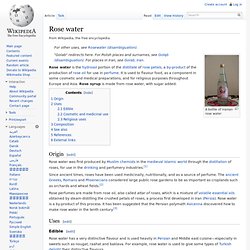
It is used to flavour food, as a component in some cosmetic and medical preparations, and for religious purposes throughout Europe and Asia. Rose syrup is made from rose water, with sugar added. Origin[edit] Horseradish Information Council - tips on horseradish, horseradish sauce, horseradish recipes. Horseradish. Sections of roots of the horseradish plant Foliage of the horseradish plant Horseradish (Armoracia rusticana, syn.
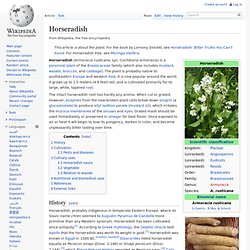
Cochlearia armoracia) is a perennial plant of the Brassicaceae family (which also includes mustard, wasabi, broccoli, and cabbage). The plant is probably native to southeastern Europe and western Asia. It is now popular around the world. The intact horseradish root has hardly any aroma. History[edit] Mastering the Art of Herbs & Spices. In my quest to learn to be able to excel still more in combining herbs and spices in my cooking for the best overall flavor and variety, I have wanted to explore more in detail this fine art.

My question has always been: what combines well with this spice? What spice would go well with this meat, vegetable, etc? And the list goes on. Dill and Garlic Green Beans. Cookbook:Latkes. Cookbook | Ingredients | Recipes Latkes are potato pancakes, commonly associated with the Jewish cultural tradition in the United States and Europe.

They can be and are served any time, but traditionally form part of the menu during the celebration of Chanukah. Parsnip latkes with horseradish and dill. I have this affliction or maybe you could call it a fixation with latkes.

And I know you’re probably thinking, potato pancakes? With shredded onion? They’re good, but are they really worth obsessing over? But you’d be using the literal definition of latkes and to me, latkes are not so much a singular recipe with a finite ingredient list but an approach to pancakes; an approach that could include anything that can be shredded and fried. Spices_A-Z.pdf. How to Combine Spices. Use our spice primer to learn what spices go with which foods, and how to experiment. So you’ve stocked your cupboard and are eager to spice up your meals.
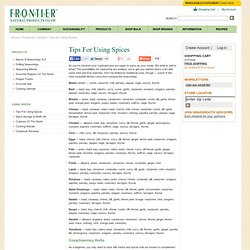
But what to add to what? The possibilities for seasoning are endless, but to get you started here's a list with some tried and true matches. Don’t be limited by traditional uses, though — some of the most exquisite dishes come from unexpected seasonings. Wheat Flours. Substitutes:For general baking whole wheat flour (Replace no more than half of the all-purpose flour with this and add half again as much baking powder plus a bit more liquid to the recipe. Compared to all-purpose flour, whole wheat flour makes baked goods denser and coarser in texture. It provides more fiber but about the same nutrients as enriched all-purpose flour.) OR self-rising flour (Omit salt and baking powder from recipe. Non-Wheat Flours. How to Make Yogurt - Homemade Yogurt Recipe with Instructions. Cookbook:Dovga. Cookbook | Ingredients | Recipes Dovga (Dovğа) – is a national meal of Azerbaijani cuisine. It is yogurt milk soup. Dovga can be eaten both cold and warm. Grilled Kebabs - ALIZEH.
Cooking Concepts. HerbsandSpices-1.png (PNG Image, 1162 × 1945 pixels) - Scaled (62%) Armenian Spices. Dolma. Names and etymology[edit] Dolma cooked with olive oil without minced meat is sometimes called yalancı dolma, "yalancı" literally meaning 'liar' (which in this case means 'false' or 'fake') in Turkish.[5][6] Asida. Rennet. Telemea. Telemea[1][source needs translation] (Romanian pronunciation: [teleˈme̯a]) is the name of the traditional Romanian cheese. The term encompasses cheese made out of cow milk and more often, sheep milk. Caş. Caș[1] (Romanian pronunciation: [kaʃ]), is a type of semi-soft fresh white cheese produced in Romania.[2] It is unsalted (sometimes lightly salted), made out of sheep milk or cow milk. Pease pudding. Ottoman cuisine. Ottoman cuisine is the cuisine of the Ottoman Empire and its successors in Anatolia, the Balkans, the Caucasus and much of the Middle East and North Africa.
Sarma (food) Turkish yaprak sarma (with grape leaves) Sarma is a dish of grape, cabbage or chard leaves rolled around a filling usually based on minced meat, or a sweet dish of filo dough wrapped around a filling often of various kinds of chopped nuts. It is found in the cuisines of the former Ottoman Empire from the Middle East to the Balkans and Central Europe. Sarma means 'a wrapped thing' in the Turkish language, from the verb sarmak 'to wrap' or 'to roll'.[1] Yaprak Sarma (grape leaves with meat) may also be commonly called yaprak dolması 'filled leaf' or simply dolma 'stuffed thing', although linguisticallyit is not correct.
Mămăligă. Mămăligă. Žganci. Atole. Pemmican. Rubaboo. Gofio. Kačamak. A Viking feast. BrickWood Ovens.